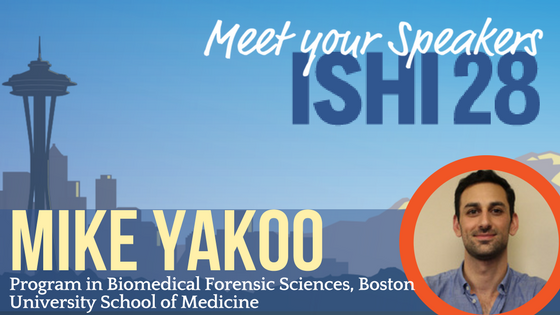The ISHI agenda is live and includes great talks from amazing speakers! While the forensic community is a tight-knit group, we can always get a little closer, right? With that in mind, we interviewed our speakers to preview their presentations and to get to know them a little better outside of their work. We’ve been posting their responses in a feature we like to call Under the Microscope.
Today, we’re chatting with Mike Yakoo, who will be presenting The Development and Optimization of a Direct Lysis Differential Extraction Process during the General Sessions on Thursday, October 5th.
Can you briefly describe the pros and cons of the Gill method for separating sperm and epithelial cells?
- Pros: front-end cell lysis is great at keeping sperm DNA out of solution; the method has been relied on for over 30 years, proving its effectiveness
- Cons: it’s a labor-intensive process and the final result isn’t always what is considered ideal. The DNA profile generated from a sperm fraction is sometimes a mixture and in cases with extreme male-to-female ratios, entirely from the female contributor
How long does the Gill method take from mixed sample to separated sperm and epithelial cells?
That depends greatly upon the exact protocol being followed. Variations in incubation times for respective epithelial and sperm fractions and the number of wash steps used to clean up the sperm pellet can greatly influence how long the protocol takes. A 2-hour lysis for each fraction plus the time required to centrifuge and wash the sperm pellet multiple times can easily take up to 5 hours. This, of course, doesn’t factor in the time it takes to do the DNA purification.
Can you briefly describe how the method you’re presenting will benefit labs?
This method greatly shortens the amount of time required to produce PCR-ready sperm fractions from cell mixtures. Because there is only one centrifugation step, it’s highly amenable to automation using liquid handling robots. The method presented needs further optimization and validation. Assuming that the method works as visualized, it would allow the lab to process more samples with their current resources in a much shortened time and with excellent recovery of DNA from the starting sample of evidence.
How did you become involved in this project?
My research advisor, Dr. Robin Cotton, has been working to develop a direct lysis method to process epithelial cell/sperm mixtures. She presented the opportunity to me and I was immediately intrigued.
What do you think are likely to be the most exciting developments for the industry over the next couple of years?
While I’m not one to speculate on these sorts of things, I think forensic DNA analysis might be making a shift towards next generation sequencing. Additionally, the collaborations that are happening between experts and researchers in various disciplines, I think, have the potential to make significant contributions to forensic DNA analysis.
What tips would you give to someone who is just starting out in the forensics field, or what’s the best advise you’ve ever received?
Trust, but verify. Hands down the best advice I’ve ever received.
How did you become interested in forensics?
Forensic Files—I know, so cliché!
When you’re not at work, what do you most enjoy doing?
Definitely running. I moved to Boston from San Diego so I’ve reconciled with running along the Charles River as opposed to San Diego’s beautiful beaches.
For those who are on the fence about registering for the upcoming ISHI, please share your thoughts and reasons why they should attend.
ISHI is actually my first forensic science conference so not only am I excited to be speaking but I’m equally excited to learn about the latest research that’s being conducted and meeting experts from all around the country.
WOULD YOU LIKE TO SEE MORE ARTICLES LIKE THIS? SUBSCRIBE TO THE ISHI BLOG BELOW!


